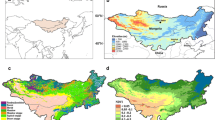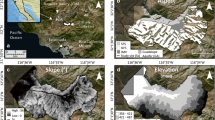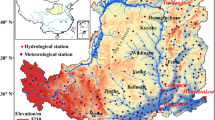Abstract
This study investigated the seasonal variations of the normalized difference vegetation index (NDVI) and its relationships with climatic variables and topography in a small-scale (20 km×20 km) area (i.e., Tsogt-Ovoo village) within the desert steppe zone of Mongolia using in-situ observed climate data and satellite remote sensing data. We found that the topography is very important for vegetation growth in the desert steppe although the summer precipitation is the constraining factor. The unexpectedly high NDVI (up to 0.56), as well as the high aboveground biomass, in the valley bottom was primarily resulted from the topography-modulated redistribution of overland flow after relatively heavy precipitation events during the growing season. This makes the valley bottoms in desert steppes not only reliable feeding resources for livestock but also heavens for wild lives. But, the detected large standard deviation of annual maximum NDVI (NDVImax) from 2000 to 2013 in the valley bottom in response to rather variable precipitation implies that the valley bottoms under desert steppe climates are more vulnerable to climatic change.
Similar content being viewed by others
References
Cheng Y, Tsubo M, Ito T Y, et al. 2011. Impact of rainfall variability and grazing pressure on plant diversity in Mongolian grasslands. Journal of Arid Environments, 75(5): 471–476.
Chuluun T, Ojima D. 2002. Land use change and carbon cycle in arid and semi-arid lands of East and Central Asia. Science in China (Series C), 45(Suppl.): 48–54.
Dagvadorj D, Batjargal Z, Natsagdorj L. 2014. Mongolia second Assessment Report on Climate Change-2014. Ministry of Environment and Green Development of Mongolia. Ulaanbaatar, Mongolia. 37-52.
Fensholt R, Langanke T, Rasmussen K, et al. 2012. Greenness in semi-arid areas across the globe 1981–2007—an earth observing satellite based analysis of trends and drivers. Remote Sensing of Environment, 121: 144–158.
Guo L H, Wu S H, Zhao D S, et al. 2014. NDVI-based vegetation change in Inner Mongolia from 1982 to 2006 and its relationship to climate at the biome scale. Advances in Meteorology, 2014: 692068.
Ignatavicius G, Sinkevicius S, Ložyte A. 2013. Effects of grassland management on plant communities. Ekologija, 59(2): 99–110.
Ishizuka M, Mikami M, Yamada Y, et al. 2012. Does ground surface soil aggregation affect transition of the wind speed threshold for saltation and dust emission?. Scientific Online Letters on the Atmosphere Sola, 8: 129–132.
Iwasaki H. 2006. Impact of interannual variability of meteorological parameters on vegetation activity over Mongolia. Journal of the Meteorological Society of Japan Series II, 84(4): 745–762.
Jambaajamts B. 1989. Climate of Mongolia. Ulaanbaatar: Ulsiin Hevlel Publishers. (in Mongolian)
Jarlan L, Driouech F, Tourre Y, et al. 2014. Spatio-temporal variability of vegetation cover over Morocco (1982–2008): linkages with large scale climate and predictability. International Journal of Climatology, 34(4): 1245–1261.
Johnson D A, Sheehy D P, Miller D, et al. 2006. Mongolian rangelands in transition. Sécheresse, 17(1–2): 133–141.
Li S G, Asanuma J, Kotani A, et al. 2007. Evapotranspiration from a Mongolian steppe under grazing and its environmental constraints. Journal of Hydrology, 333(1): 133–143.
Li Z Q, Guo X L. 2012. Detecting climate effects on vegetation in northern mixed prairie using NOAA AVHRR 1-km time-series NDVI data. Remote Sensing, 4(1): 120–134.
Li Z Q, Guo X L. 2014. Topographic effects on vegetation biomass in semiarid mixed grassland under climate change using AVHRR NDVI data. British Journal of Environment and Climate Change, 4(2): 229–242.
Lu L, Li X, Veroustraete F, et al. 2009. Analysing the forcing mechanisms for net primary productivity changes in the Heihe river basin, north-west China. International Journal of Remote Sensing, 30(3): 793–816.
Ma W H, Fang J Y, Yang Y H, et al. 2010. Biomass carbon stocks and their changes in northern China’s grasslands during 1982–2006. Science China Life Sciences, 53(7): 841–850.
Mayes M T, Mustard J F, Melillo J M. 2015. Forest cover change in Miombo woodlands: modeling land cover of African dry tropical forests with linear spectral mixture analysis. Remote Sensing of Environment, 165: 203–215.
Miller D, Sheehy D. 2008. The relevance of Owen Lattimore’s writings for nomadic pastoralism research and development in inner Asia. Nomadic Peoples, 12(2): 103–115.
Miyazaki S, Yasunari T, Miyamoto T, et al. 2004. Agrometeorological conditions of grassland vegetation in central Mongolia and their impact for leaf area growth. Journal of Geophysical Research, 109(D22): D22106.
Munkhtsetseg E, Kimura R, Wang J, et al. 2007. Pasture yield response to precipitation and high temperature in Mongolia. Journal of Arid Environments, 70(1): 94–110.
Ni J. 2003. Plant functional types and climate along a precipitation gradient in temperate grasslands, north-east China and south-east Mongolia. Journal of Arid Environments, 53(4): 501–516.
Pettorelli N, Vik J O, Mysterud A, et al. 2005. Using the satellite-derived NDVI to assess ecological responses to environmental change. Trends in Ecology & Evolution, 20(9): 503–510.
Ridd M K. 1995. Exploring a V-I-S (vegetation-impervious surface-soil) model for urban ecosystem analysis through remote sensing: comparative anatomy for cities. International Journal of Remote Sensing, 16(12): 2165–2185.
Saizen I, Maekawa A, Yamamura N. 2010. Spatial analysis of time-series changes in livestock distribution by detection of local spatial associations in Mongolia. Applied Geography, 30(4): 639–649.
Sayemuzzaman M, Jha M K. 2014. Seasonal and annual precipitation time series trend analysis in North Carolina, United States. Atmospheric Research, 137: 183–194.
Seneviratne S I, Koster R D. 2012. A revised framework for analyzing soil moisture memory in climate data: derivation and interpretation. Journal of Hydrometeorology, 13(1): 404–412.
Stumpp M, Wesche K, Retzer V, et al. 2005. Impact of grazing livestock and distance from water source on soil fertility in southern Mongolia. Mountain Research and Development, 25(3): 244–251.
Vandandorj S, Gantsetseg B, Boldgiv B. 2015. Spatial and temporal variability in vegetation cover of Mongolia and its implications. Journal of Arid Land, 7(4): 450–461.
Wang J, Price K P, Rich P M. 2001. Spatial patterns of NDVI in response to precipitation and temperature in the central Great Plains. International Journal of Remote Sensing, 22(18): 3827–3844.
Wang J, Rich P M, Price K P. 2003. Temporal responses of NDVI to precipitation and temperature in the central Great Plains, USA. International Journal of Remote Sensing, 24(11): 2345–2364.
Wang X M, Chen F H, Dong Z B, et al. 2006. The relative role of climatic and human factors in desertification in semiarid China. Global Environmental Change, 16(1): 48–57.
Weng Q H, Lu D S. 2009. Landscape as a continuum: an examination of the urban landscape structures and dynamics of Indianapolis City, 1991–2000, by using satellite images. International Journal of Remote Sensing, 30(10): 2547–2577.
Yamanaka T, Kaihotsu I, Oyunbaatar D, et al. 2007. Summertime soil hydrological cycle and surface energy balance on the Mongolian steppe. Journal of Arid Environments, 69(1): 65–79.
Yin H, Udelhoven T, Fensholt R, et al. 2012. How normalized difference vegetation index (NDVI) trends from advanced very high resolution radiometer (AVHRR) and système probatoire d’Observation de la Terre VEGETATION (SPOT VGT) time series differ in agricultural areas: an Inner Mongolian case study. Remote Sensing, 4(11): 3364–3389.
Yu F F, Price K P, Ellis J, et al. 2003. Response of seasonal vegetation development to climatic variations in eastern central Asia. Remote Sensing of Environment, 87(1): 42–54.
Yue W Z, Xu J H, Wu J W, et al. 2006. Remote sensing of spatial patterns of urban renewal using linear spectral mixture analysis: a case of central urban area of Shanghai (1997–2000). Chinese Science Bulletin, 51(8): 977–986.
Yunatov A A. 1976. Fundamental Characteristics of the Vegetation of Mongolian People’s Republic. Ulaanbaatar: Mongolian Academy of Science. (in Mongolian)
Zhang J Y, Dong W J, Fu C B, et al. 2003. The influence of vegetation cover on summer precipitation in China: a statistical analysis of NDVI and climate data. Advances in Atmospheric Sciences, 20(6): 1002–1006.
Zhang X Y, Hu Y F, Zhuang D F, et al. 2009. NDVI spatial pattern and its differentiation on the Mongolian Plateau. Journal of Geographical Sciences, 19(4): 403–415.
Zhang Y S, Munkhtsetseg E, Kadota T, et al. 2005. An observational study of ecohydrology of a sparse grassland at the edge of the Eurasian cryosphere in Mongolia. Journal of Geophysical Research, 110(D14): D14103.
Zhao X, Hu H F, Shen H H, et al. 2015. Satellite-indicated long-term vegetation changes and their drivers on the Mongolian Plateau. Landscape Ecology, 30(9): 1599–1611.
Zhou L, Kaufmann R K, Tian Y, et al. 2003. Relation between interannual variations in satellite measures of northern forest greenness and climate between 1982 and 1999. Journal of Geophysical Research, 108(D1): ACL 3-1–ACL 3-16.
Zhu Z C, Bi J, Pan Y Z, et al. 2013. Global data sets of vegetation leaf area index (LAI) 3g and fraction of photosynthetically active radiation (FPAR) 3g derived from global inventory modeling and mapping studies (GIMMS) normalized difference vegetation index (NDVI3g) for the period 1981 to 2011. Remote Sensing, 5(2): 927–948.
Acknowledgments
This research was financially supported by the Japan Society for the Promotion of Science RONPAKU Program (MECS-11319), a Budget Request of Tottori University, and sponsored by special coordination funds from the Ministry of Education, Culture, Sports, Science and Technology of the Japan.
Author information
Authors and Affiliations
Corresponding author
Rights and permissions
About this article
Cite this article
Gantsetseg, B., Ishizuka, M., Kurosaki, Y. et al. Topographical and hydrological effects on meso-scale vegetation in desert steppe, Mongolia. J. Arid Land 9, 132–142 (2017). https://doi.org/10.1007/s40333-016-0090-z
Received:
Revised:
Accepted:
Published:
Issue Date:
DOI: https://doi.org/10.1007/s40333-016-0090-z




